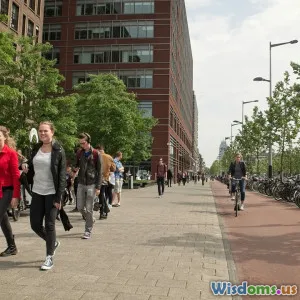
Can Green Transportation Investments Pay Off Sooner Than You Think
8 min read Discover how investments in green transportation can yield financial and environmental returns faster than expected. (0 Reviews)
Can Green Transportation Investments Pay Off Sooner Than You Think?
Introduction
Imagine a world where investing in eco-friendly transportation not only helps save the planet but also boosts your financial bottom line far sooner than anticipated. Green transportation has long been touted as a necessary leap for sustainability, yet many linger in doubts about the timeline for recouping such investments. Contrary to common perceptions, mounting evidence suggests that green transportation investments can pay off faster than commonly assumed—benefiting the economy, public health, and innovation.
This article explores why these investments are not just ethically compelling but financially savvy. By delving into cutting-edge examples, data, and expert insights, we'll uncover how government policies, business initiatives, and consumer trends are driving a rapid return on this green shift.
The Compelling Case for Green Transportation
Low-carbon and zero-emission vehicles, sustainable public transit, and infrastructure for biking and walking constitute pillars of green transportation. Beyond reducing carbon footprints, these solutions carry economic and societal benefits:
- Economic savings on fuel and operational costs
- Reduced healthcare expenses due to better air quality
- Job creation in green sectors
Real-World Impact: Electric Vehicles (EVs)
Let's consider the electric vehicle market: in 2023, global EV sales hit 16.5 million—almost double the figures in 2021, driven by declining battery prices and supportive policies. The BloombergNEF battery price index shows a nearly 90% drop since 2010, making EVs more affordable and cost-effective to operate.
According to a 2022 Department of Energy report, EV owners can save an average of 63% on fuel costs compared to conventional vehicle owners. These immediate operational savings can absorb upfront costs rapidly, often within 3-5 years.
How Green Investments Accelerate Payoff
Falling Technology Costs
One key driver: continued technology cost declines. Battery prices, solar-powered charging stations, and smart mobility apps have improving ROI figures yearly. This means that electric buses, bike-share systems, or energy-saving signaling at intersections become financially viable sooner than earlier projections suggested.
Government Incentives & Subsidies
Governments worldwide incentivize green transportation investments. For example, the U.S.'s Inflation Reduction Act offers up to $7,500 in EV tax credits and significant backing for charging infrastructure, accelerating adoption.
European countries have substantial grants and subsidies for electric fleet conversions. These programs effectively reduce payback periods, turning what once seemed like 'green luxuries' into economically justifiable decisions.
Public Health and Social Cost Savings
A groundbreaking 2021 WHO study estimated that air pollution leads to approximately 7 million premature deaths annually worldwide. Transitioning to green transportation systems cuts these health risks, lowering public healthcare costs.
For instance, cities investing in expanded cycling infrastructure not only improve residents’ health and reduce congestion but experience economic benefits stemming from a healthier workforce and fewer medical expenses.
Business Agility and Brand Value
More corporations embrace sustainability as a core strategy. Logistics giants like UPS have integrated hybrid and electric delivery trucks, reporting fuel cost savings alongside enhanced public perception.
According to McKinsey, companies prioritizing green transport often attract better investment and customer loyalty, leading to improved market share that benefits their long-term profitability.
Cases Demonstrating Swift Returns
Oslo, Norway: A Pioneer in Electric Mobility
Oslo’s aggressive policies have led to EVs comprising over 70% of new car sales. Initial investments in charging infrastructure and incentives have quickly translated into:
- Reduced city noise and pollution
- Savings on municipal fleet operation costs
- Increased tourism drawn by Oslo’s clean-air reputation
The city reports recouping infrastructure costs within 7 years—much faster than comparable public works.
Shenzhen, China: Electric Bus Revolution
Shenzhen transitioned its entire 16,000-strong bus fleet to electric by 2019, thanks to strong government support and technology advances.
The payoff was swift: lowered fuel and maintenance costs caused the city to break even on the investment in roughly 5 years, while daily emissions plummeted.
Overcoming Barriers to Realizing Return
Initial Capital Constraints
Though green transportation investments can pay off quickly, upfront costs may remain prohibitive without creative financing. Public-private partnerships, green bonds, and innovative leasing models can enable faster deployment.
Infrastructure Development Speed
Scaling infrastructure—like charging stations and bike lanes—is crucial. Agile project management and community involvement are critical to translating potential into early returns.
Consumer Behavior and Awareness
Proactive education and incentive programs help accelerate acceptance and habitual use of green transportation options, speeding up returns indirectly.
Conclusion: The Time to Invest is Now
Green transportation is no longer a vague ideal or a long-term gamble. Declining costs, expanding policies, and social awareness combine to deliver tangible, near-term payoffs.
From cities like Oslo and Shenzhen to individual EV owners saving thousands each year, evidence points to the rapid financial and environmental benefits of green transportation investments. As global pressure mounts to combat climate change, those who act swiftly by deploying smart green transport initiatives stand to gain—not only in profits but in resilience, public health, and international leadership.
Seize the opportunity now: with strategic planning, supportive policies, and community engagement, green transportation investments truly can pay off sooner than you think.
References:
- BloombergNEF. (2023). Battery Price Index.
- U.S. Department of Energy. (2022). Fuel Cost Comparison.
- World Health Organization. (2021). Ambient Air Pollution and Health.
- McKinsey & Company. (2022). Sustainable Business Practices and Returns.
Author’s Note: This analysis underscores that greener choices are not only our moral imperative but can deliver impactful economic results in surprisingly short timelines.
Rate the Post
User Reviews
Popular Posts


















